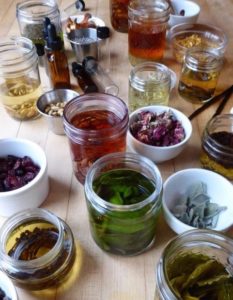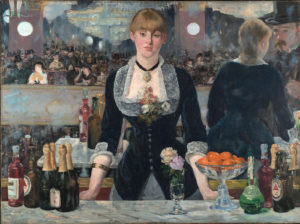-Pam Scott-
My personal interest in Bitters started a few years ago using them as a cocktail enhancers. I like to drink alcohol, but don’t like to take the time to feel bad the next day, so my hard and fast rule became two cocktails, no more, and they had better be damn good and interesting. Using bitters as a cocktail enhancer started in the 18th century. Since most early spirits were not very refined and frequently unpalatable, it became popular to use bitters to spice up the undrinkable. This was the beginning of the cocktail. Cocktails had a resurgence in the 1920’s during prohibition when people found themselves drinking things from questionable sources.

The first recorded use of bitters medicinally was about 2000 years ago. This bitters mixture was used as an antidote for poison. This mixture included gentian root, ginger root, St. John’s wort, myrrh, cinnamon, and opium, all blended with honey. This particular recipe became a cure-all in Rome, even being applied to open wounds. The basic bitters formula that was developed back then and is still in use now is: a bitter root, herb or berry; an aromatic; and sweetness for balance in the taste receptors.
The bitter taste receptors, when stimulated, elicit an eversion response. This could have evolved in humans because most toxic and poisonous plants are bitter. When tasted or even smelled, bitter plants will stimulate the digestive system. Bitters are thus used to settle an upset stomach, bloating, and cramping, because the digestive system is kicked into gear. Bitters will pump up the metabolism of the liver, increasing the production of bile and eliminating waste products from the bloodstream. Stimulating the bitter taste receptors has been used to treat acne, allergies, asthma, headaches, and it can regulate the appetite. The use of plant extracts in the form of tinctures has been employed medicinally for thousands of years.

When ingesting plants you take in primary plant metabolites; these are starches, proteins and fats, for energy and tissue-building. You also ingest secondary plant metabolites. These contain vitamins, minerals and phytonutrients. Phytonutrients are the growth regulators, insect repellents or attractants, and many other plant mechanisms. These secondary plant metabolites taste bitter and are full of nutrients. These nutrients are often stripped away in food processing and plant hybridization, and are not as available in modern diets as they once were. Plant secondary metabolites and phytochemicals can be extracted from a plant source by using high-proof alcohol. Some can be extracted easily with water. Others need a saponin to help extract them. Saponins are soap like substance found in plants that helps strip the protective coating from a bitter element.
If making bitters medicinally or creating your own bitters combinations, you may want to make your own individual tinctures. That way you can easily control the taste and medicinal content of the bitters mix. When making tinctures, you steep an herb, root, bark or berry in a specific proof of alcohol for a specific amount of time to release the secondary plant metabolites, vitamins, minerals and phytonutrients. You want to get to know the plants, their interactive qualities and benefits. Plants are strong medicine, be aware of allergies to plants such as chamomile, quinine, and wormwood. You are extracting the most powerful part of the plant.
When building a bitters mixture, you want to make it palatable. You want a bittering agent, a flavoring agent and sweet element such as honey sugar or molasses. These agents are extracted, and suspended in an alcohol; such as vodka (80-100 proof) rum (151 proof or less), brandy (90 – 100 proof), or grain alcohol (150 proof).
People have mixed bitters in alcohols for a very long time. The bittering agent in beer is hops. It balances out the sweetness in the grain, but it was not always the bitter of choice for beer brewing. Marjoram and other herbs have been used in the past. The Mayans used cocoa as the bitter of choice in their fermented drinks. This was mixed with vanilla bean and honey, and used medicinally as well as ritually. I recently added a dash of my coffee pecan bitters to hot cocoa and thought it was the best thing I had ever put in my mouth. This is now my desert of choice at dinner parties. Bitter roots and herbs add balance to the palate, and it is a taste humans naturally crave.
There are plenty of wonderful books to read and recipes to try out there, but one of my all time favorites is one that I adapted from the book “Bitters, a Spirited History of a Classic Cure All” by Brad Thomas Parsons. He inspired me to break out on my own and experiment, helping me come up with a most wonderful concoction. I have included my recipe below. I hope you are inspired by my blog to try bitters making.
Busters Brew
By Pam Scott
- 2 tbsp chopped dried orange peel
- Zest of one orange
- ¼ cup dried sour cherries
- ¼ cup ripe raisins
- 5 cracked cardamom pods
- 2 cinnamon sticks
- 1 star anise
- 1 vanilla bean or ½ tsp pure vanilla extract
- ¼ tsp whole cloves
- ½ tsp cinchona bark
- ½ tsp sarsaparilla root
- ¼ tsp quassia chips
- ¼ tsp gentian root
- ½ tsp cassia chips
- ¼ dried black walnut leaf
- 2 cups high proof rum or rye whiskey
- 1 cup water
- 2 tbsp simple syrup made with demerara sugar
Instructions:
Place all ingredients except for the alcohol, water and simple syrup in a quart sized mason jar
Pour in the 2 cups of your alcohol
Seal jar and store at room temperature out of sunlight for 2 weeks, shaking vigorously daily.
After 2 weeks, strain the liquid through a cheesecloth lined funnel into another quart sized jar, removing all the solids. Repeat until all of the sediment has been filtered out. Squeeze the cheesecloth over the jar to release any excess liquid and transfer the solids into a small saucepan. Cover the jar and set aside.
Cover the solids in the saucepan with the water and bring to a boil over medium high heat. Reduce heat and simmer for about 10 minutes.
Remove pan from heat and let completely cool. Once it has cooled, add the contents from the pan into another quart sized mason jar. Cover the jar and keep at room temperature and out of direct sunlight for a week shaking daily.
After a week, strain the jar with the liquid completely through a cheesecloth lined funnel into a clean quart mason jar. Discard the solids. Make sure that you strain all the sediment out. Add this to the alcohol that you have in the other mason jar.
Add the simple syrup to the jar.
Allow mixture to stand at room temperature for 3 days. After that, skim off any debris that floats to the top. Then pour mixture through the cheesecloth-lined funnel one last time for good measure.
You can use the funnel to fill small woozy bottles with the liquid. Remember to shake before you use your new bitters. You are done! Yum!!
We hope you have fun!

Kristin says
Thanks for sharing, Pam!